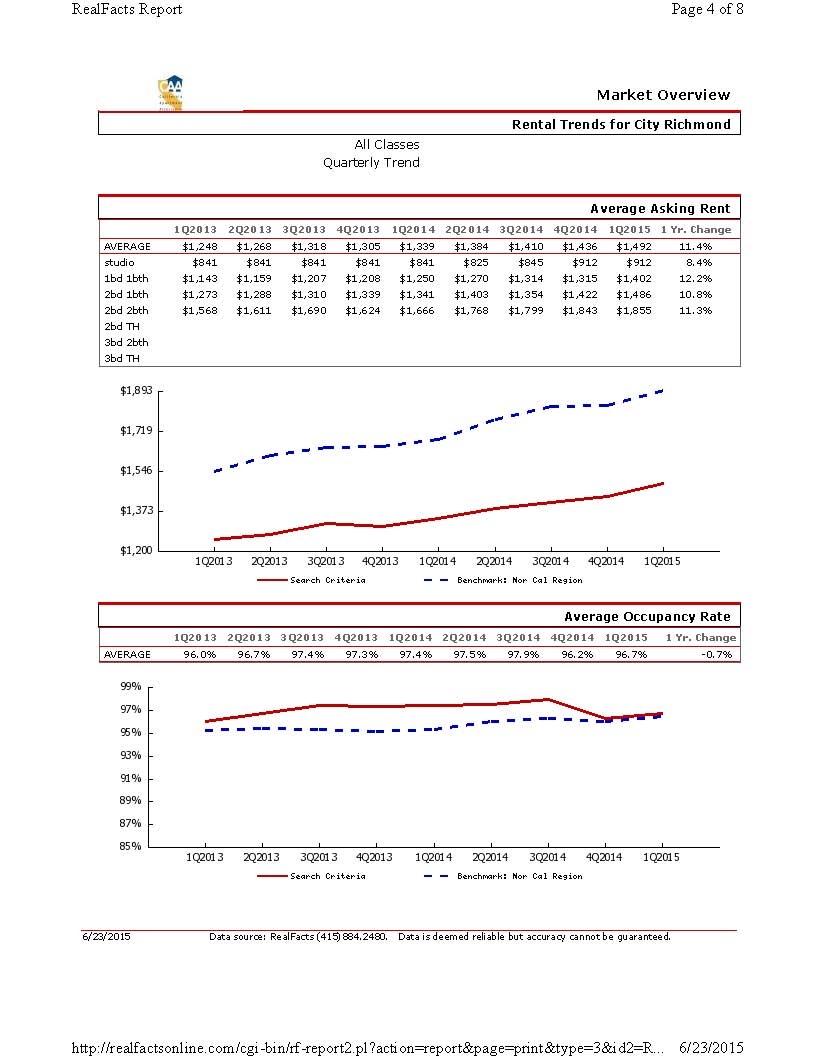| |
We have the run up to tonight’s vote on the second reading of the Rent Control and Just Cause Ordinance. Below are two articles, one by the San Francisco Chronicle and the other by RPA leader Mike Parker rebutting my E-FORUM posting Open Season on Landlords, July 26, 2015.
Mike Parker demonstrates a lack of understanding of the rental housing investment market in many ways. Mike states, “A landlord’s profit is not the CPI. A landlord’s profit rate comes from two sources. First it comes from the increase in value of the property the landlord owns.” This presumes that rental property investors are more like day traders, cashing in on appreciation while not worrying about cash flow. There is no basis for this assertion, and it is a disservice to most investors, particularly the mom and pop type who own most of the older housing stock subject to rent control. Parker also completely ignores that the fact that the value of rental real property doesn’t always go up. All real estate took a significant nose dove during the recession years, something he should have known because of his support for eminent domain to bail out underwater homeowners. Well, there were also plenty of underwater landlords at the same time, but they were undeserved of any RPA sympathy.
Parker also states, “For example property tax increases, a major part of landlord costs, are currently capped at 2%. In addition, it is possible for landlords who make capital improvements or have hardship situations to get rent increases to cover these.” The fact is that the 2% cap does not apply when a property is sold ( a sale cannot end a rental agreement or lease) or when a property is reassessed upward after having been reassessed downward during the recession. The 2% applies to the base valuation when the property was first acquired, not to year-to-year adjustments.
In the Chronicle article, the phenomenon of black out-migration continues to be cited as if it explains everything: “ Proponents also hope rent control will curb the erosion of the city’s black population, which fell by 35 percent between 2000 and 2013, according to a recent Haas Institute report on gentrification in Richmond. African Americans now represent 24 percent of the population, while the Latino population is steadily rising.” The fact is that the black population has been more than replaced with a Latino demographic, while the white ratio has been largely static. How this heralds gentrification is incomprehensible, yet rent control and just cause advocates continue to point to it as evidence that rent control is needed. Blacks replaced by Latinos = gentrification? If someone can explain this to me, I would like to hear it.
Richmond’s RPA/ACCE bloc supporting rent control and just cause continue to exercise government by rumor mill. They all know someone who knows someone who allegedly has been abused by a landlord or priced out of Richmond, but they have never provided any data to support the actual details or scope of the alleged problem. To them, just a story of a $200 rent increase is all the evidence they need.
Case in point, the Chronicle article quotes Andres Soto, “When Soto, the Richmond organizer for the nonprofit Communities for a Better Environment, was evicted in 2010, he thought he could easily find an apartment. But rents had ballooned, he said, with a one-bedroom in his old neighborhood going for $1,800.” When Soto left Richmond, the average rent for a 1-bedroom apartment was actually less than $1,100. Even now, more than four years after Soto moved to Benicia, there are one-bedroom units available in Richmond for well under $1,800. In fact the latest data (1st Quarter 2015) shows the average rent in Richmond for a 1-bedroom apartment is $1,402 – a long way from the $1,800 cited by Soto.

The Summit at Hilltop (photo below) is advertising 1-bedroom apartments at $1,181, and Bella Vista at Hilltop has one for $1,425. I found on in Marina Bay for $1,650.

Richmond council to vote on contentious rent-control proposal
By Rachel Swan

Photo: Liz Hafalia, The Chronicle
Andres Soto talks about Richmond rents in his office in downtown Richmond, Calif., on Monday, July 27, 2015. Soto founded Richmond Progressive Alliance 10 years ago leading the campaign for rent control intending to shield longtime residents from displacement.
Andres Soto talks about Richmond rents in his office in downtown Richmond, Calif., on Monday, July 27, 2015. Soto founded Richmond Progressive Alliance 10 years ago leading the campaign for rent control intending to shield longtime residents from displacement.
Andres Soto was a leading voice for rent control in Richmond for more than a decade, before he got displaced from his hometown to a mobile home in Benicia.
“I’d been paying $1,100 a month for a three-bedroom house on Lowell Street, with a front yard, backyard and fruit trees,” Soto, 60, said of the home he rented for 29 years in the northeastern part of the city.
When Soto, the Richmond organizer for the nonprofit Communities for a Better Environment, was evicted in 2010, he thought he could easily find an apartment. But rents had ballooned, he said, with a one-bedroom in his old neighborhood going for $1,800.
Since then, the impact of rising rents has become a raw topic in Richmond, a staunchly working-class city seeing the first inklings of gentrification. The median rent rose 13 percent between January 2014 and January 2015, according to UC Berkeley’s Haas Institute for a Fair and Inclusive Society.
On Tuesday, the City Council is poised to fight back and make Richmond the first California city in 30 years to institute rent control. The law, which would limit hikes to the level of increases in the regional Consumer Price Index — roughly 2 percent a year — would stabilize rents for an estimated 10,000 households and require that landlords show “just cause” to evict tenants.
The ordinance is meant to shield longtime residents from an economic boom that seems inevitable. But opponents of rent control in Richmond say it’s unfair to landlords. And they note that the law will apply to only a portion of tenants — while forcing property owners to raise rents for everyone else.
Proponents also hope rent control will curb the erosion of the city’s black population, which fell by 35 percent between 2000 and 2013, according to a recent Haas Institute report on gentrification in Richmond. African Americans now represent 24 percent of the population, while the Latino population is steadily rising.
“It’s not like we’ve suddenly got 200 new white people who’ve moved down the block,” said Richard Boyd, a community activist and resident of the Iron Triangle neighborhood, which includes the city’s downtown corridor.
Still, Boyd noted, new signs of prosperity have put many of his neighbors on edge.
“You hear people talking about it,” he said. “I know the rents are going up, and people are being displaced.”
Boyd, like others, sees Richmond heading toward a more prosperous future. Homicides and other violent crimes have plummeted. Parks are getting restored. A ferry line to San Francisco is expected to open in late 2017 or early 2018.
Housing woes
But the city’s growing attractiveness and choice location have it facing the same affordable-housing crisis that has bedeviled San Francisco, Oakland and Berkeley, all of which have rent-control laws of their own.
While development and gentrification are uneven in Richmond, depending on the neighborhood, the displacement pattern resembles those of surrounding cities, said Eli Moore, who co-authored the Haas Institute report.
In the past decade, black residents have fled to Antioch, Pittsburg and parts of Solano County, where housing is cheaper but job opportunities and public transit are scarce, Moore said.
“So the community they’ve stayed in and invested in is starting to improve,” Moore said, “and they can no longer afford to live there.”
Mayor Tom Butt, who opposes the rent-control ordinance, said it won’t help the low-income people who need it most, and that it will hurt small-time landlords who are just trying to make a living.
Under the state’s Costa-Hawkins Rental Housing Act, rent control in any California city applies only to homes built before 1995, and Butt said landlords may jack up rents for everyone else. He also believes that the “just cause” component will make it difficult to evict bad tenants.
The mayor deemed the ordinance — which won preliminary approval from the City Council last Tuesday by a 4-1 vote, with two absences — a victory for three new council members who had strong backing from the Richmond Progressive Alliance, a group that helped start the rent-control campaign in 2003.
Landlords speak up
The small army of landlords who showed up to denounce the proposed law at the council meeting had objections similar to the mayor’s. Many of them were immigrant businesspeople who “saved and bought rental property for income or retirement,” Butt pointed out in an e-mail Sunday, in which he accused fellow council members of having a “visceral hate of landlords.”
Yet without rent-control laws, Richmond tenants are at the mercy of property owners, said Dean Preston, founder of the San Francisco nonprofit Tenants Together, which represents renters throughout California.
“Mayor Butt and his allies in the real estate industry believe in self-regulation and voluntary compliance,” Preston said. “And that’s just not how the real world works.”
Rachel Swan is a San Francisco Chronicle staff writer. E-mail: rswan@sfchronicle.com
Twitter: @rachelswan
Mike Parker: Open Season on Landlords? A Reply to Tom
Posted by Radio Free Richmond 20sc on July 27, 2015

Tom Butt’s latest E-Forum (reprinted below) is designed to throw gasoline on the fire. There are numerous false statements and exaggerations.
Demonizing landlords
Tom tries to make the case that supporters of Rent Control demonize all landlords. Exactly the opposite is true. Rent Control supporters went out of their way to make sure that landlords do get a fair return on their investment. We agreed to rent increases at the full Cost of Living rate (typically 3%) even though landlord costs do not go up at this rate. For example property tax increases, a major part of landlord costs, are currently capped at 2%. In addition, it is possible for landlords who make capital improvements or have hardship situations to get rent increases to cover these.
To prove his case Tom cites one quote from Jovanka Beckles. But as the quote actually makes clear, Jovanka was referring to landlords who suggested that if the city passed rent control, they would evict people as retribution. Such statements were made by landlords at the last Council meeting.
Similarly Tom attacks ACCE for “fighting back against …greedy landlords.” Although there are many good landlords, there really are greedy ones as well.
Landlord’s rate of profit.
Tom’s suggestion that we should compare the CALPERS (public workers pension fund) expected rate of return of 7.4% with the CPI increase allowed landlords is ludicrous. Tom, as a smart and successful as he is in business, knows better. A landlord’s profit is not the CPI. A landlord’s profit rate comes from two sources. First it comes from the increase in value of the property the landlord owns. Property values are going up very fast. It is true that rent control will slow down the increase of the rental property value, but it will continue to go up, as is clear in the cities that have rent control . Second profit is built into the rent that the landlord charges. A good business person pencils this out when setting the initial rent. As explained above, the CPI increase actually slightly increases the landlord’s rate of profit. So landlords who are making a fair rate of return on their investment will get a still better rate. But the CALPERSs pensioners expected real rate of return will not increase with CPI.
How the market works
In one place Tom has a good point. “The difference is that food, medical care, transportation and education are largely provided or subsidized by the public sector and augmented by the nonprofit sector. Rental housing is fundamentally different; it is predominantly provided by the private sector.”
Actually all but one of these industries are very much controlled by private interests and education is rapidly being privatized. But let’s assume that Tom is referring just to providing these services to the poor.
Tom’s examples show that in America the market “works” but it does not work well for poor and working people. Judging from results the market does work very well for the wealthy who are getting much wealthier and are virtually the only beneficiaries of all productivity gains made in America in the last two decades. Since the market works so badly for the poor, we, the public need to subsidize food, medical care, transportation as Tom says. There is some subsidy for housing also but it is not enough. And Tom is right the answer is more public works and public spending on providing affordable housing.
But public spending on housing is going down, not up. We have a rightwing Congress which is a roadblock to doing what is required. I haven’t checked but I would be willing to bet that the Apartment Owners Association and the biggest landlord’s from Trump down have spent their political money on candidates who fight government housing programs. So, until we build the kind of housing that we need, we have to do what we can to help renters live stable and sustainable lives.
Previously Incarcerated
Finally, the most appalling part of Tom’s essay is the fear mongering about previously incarcerated individuals returning to Richmond. In a previous essay he raised the specter of child molesters next door. Housing for previously incarcerated whether working or homeless is a real problem. The item being brought before the Council is simply to ask staff to look into this and present the Council with options. Housing is included in San Francisco’s Fair Chance Ordinance. Where does Tom expect the previously incarcerated to live on reentry? Does he think that making them homeless will reduce the recidivism?
Time to move on
After six months of very intense discussion, where Tom, more than anyone else, had his say through his E-Forum, interviews, and his supporters, the Richmond City Council has voted to try rent stabilization and requiring just cause for eviction. It is time to pull together to make this work as well as possible and fix problems that emerge. It is time to move on to other pressing problems in the city.
Reposted from Mike Parker of the Richmond Progressive Alliance
| |

